Capital:
Jakarta
Currency
Rupee
Best time to visit:
The climate is hot (between 22 ° C and 32 ° C) and humid all year round, with variations related to regions and altitude. In general, the dry season (more or less from May to September) is the best for traveling.
In a word:
Tidak apa-apa (no problem)
Vaccines
Malaria is present all year round in urban areas but in the more touristy areas of Java. Antimalarial prophylaxis is recommended as well as antitification. Protect yourself from mosquitoes: there is also the risk of contracting dengue.
At the table:
Indonesian cuisine includes many spicy dishes. Taste the rice, a basic ingredient of the local diet, prepared in various ways, for example fried, as in nasi goreng: the national dish; my goreng (sauteed noodles), perkedel (pancakes), satay (meat skewer with peanut sauce) and pisang goreng (banana pancakes). The fruit, varied and delicious, stimulates curiosity (there are fruits unknown to us with unusual shapes) to try!


Warnings:
- Before swimming in the sea, ask for information on the spot: on each island there are dangerous areas due to strong currents, jellyfish or other.
- During Ramadan, many public establishments observe reduced opening hours.
Essential experiences:
Admire the sunrise and sunset among the Buddhas of Borobudur; Climb the mystic volcano Bromo; be enchanted before the temple of Prambanan
Like a string of pearls in a sea of coral, the Indonesian archipelago extends, with more than 13,000 islands, from the Asian continent to the Pacific Ocean for about 5,000 km.
Just like pearls, these islands have lured men for centuries the lust for wealth. First the Chinese in search of sandalwood and beeswax, then the European navigators with cloves and nutmeg up to the Dutch attracted by the fertile fields for rice, coffee, sugar and tobacco.
Indonesia has thousands of islands with different local customs and cultures that can still offer a lost flavor of adventure. This time we will focus only on the island of Java, having already explored Bali on a previous trip.
Our suggested itinerary (22 days) | |
three days: | Jakarta, Bogor |
three days: | Bandung, Lembang |
one week: | Batu Karas (relax by the sea) |
five days: | Yogyakarta, Prambanan, Borobudur |
| four days: | Surakarta, Surabaya |
Jakarta is all Indonesia concentrated in a huge urban agglomeration and Indonesians come from all over the archipelago in search of fame or fortune.
This is the true heart of Indonesia and here the trends are affirmed, the greatest political and economic decisions are made.
The main problem of the city, from a tourist point of view, is that of not having a real center that can be explored on foot but several fulcrums separated by massive and toxic traffic jams, difficult to reach without getting a good dose of smog!
For us it is only the starting point and organization for the exploration of Java! And already tomorrow morning we will leave, by train, at a time directly from Bogor.
An hour by train from the capital: Bogor was the holiday resort of the Dutch colonizers in the hills for a long time. The main attraction is its famous botanical garden which extends over a vast lush area right in the center of the city.
Indeed, the Kebun Raya (large garden) is the very heart of Bogor. It covers an area of 80 hectares, includes streams, ponds and is home to more than 15,000 species of trees and plants, including 400 different types of palm trees and we decide to stay right in its vicinity, near the Zest Hotel, with excellent rooms and super friendly staff who knows how to pamper their customers! Good choice!





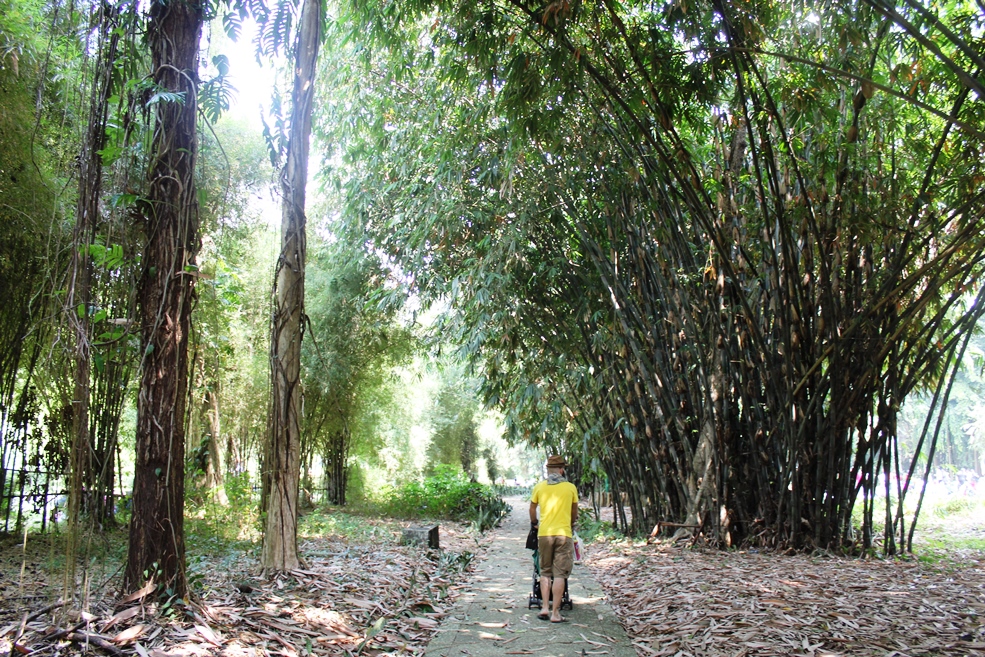







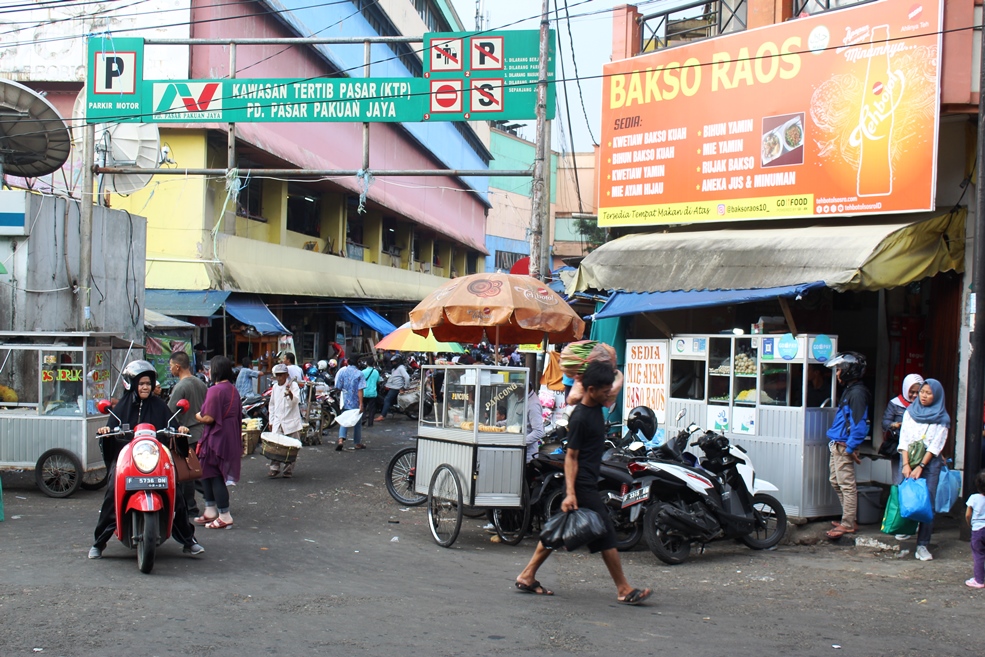







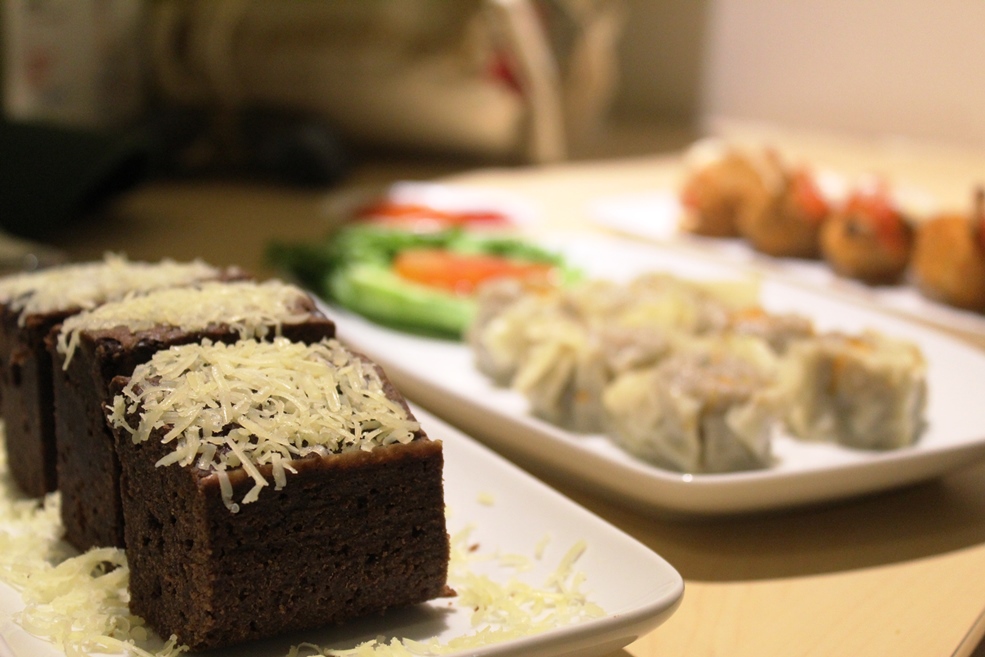

We have an exceptional guide: Dini, a beautiful local girl, who lets us discover the Old Bogor through chaotic market and always immersed in traffic at the limit of the bearable up to a wonderful Chinese temple: Hok Tek Bio, in Indonesian: Vihara Danangun.
An oasis of peace and prayer in the chaos of the city. We spend some time here while a kind Indo-Chinese gentleman explains to us the various rites of the faithful.
The transfer, by bus, to Bandung is quite challenging, we expected 2 and a half hours of travel but we have spent more than twice, fortunately, the warm welcome of Richy and his staff Zodiak Asia Afrika Hotel, the lovely hotel where we will stay, was unforgettable. Great location, practically in the city center, very nice and professional staff! Highly recommended.

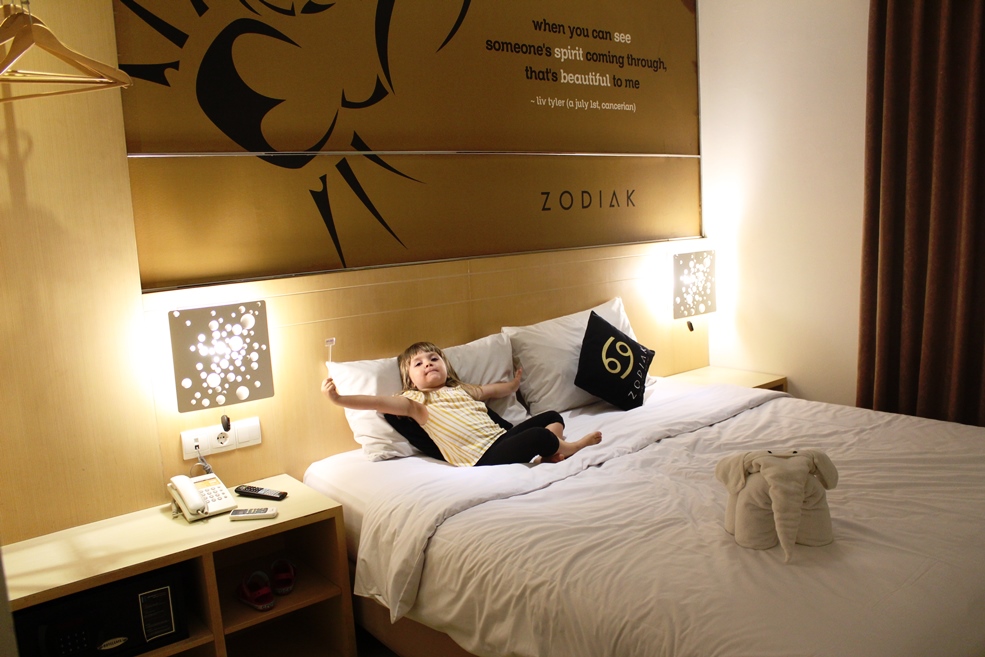

They, in the evening, invite us to dinner in a village 15 km from Bandung, a traditional Indonesian dinner, a choice of chicken and dried fish with the cook cooking in front of you! Very characteristic.
Bandung. Located at 750 meters above sea level, it enjoys a cool climate, even if, like other towns, it is a chaos of continuous traffic.
Decanted in the past as the "Paris of Java" for its many parks and gardens, today it still has some interesting old colonial buildings.
To the north and south various volcanic peaks rise, mixed with thermal springs and huge tea plantations.
The city center revolves around the JL Asia Afrika axis and the Alun Alun (central square) where the marvelous mosque rises, majestic, a meeting point and reference point for the entire city.
JL Braga is also very inviting, an elegant shopping street at the time of the Dutch domination, now a lively area of the local youth with American style cafes and fast food!
Lembang. Located on the road to Tangkuban Prahu, just 16 km from Bandung but reachable in an hour to home traffic; a bit like Bogor, also in the past, it was a famous holiday destination, today it is a lively market town famous above all for its theme park: "Floating Market".
This is really one of those perfect places to let your children go wild, essential when traveling with children! Feed the rabbits, try a thousand different specialties thanks to the many "street food" boats on the lake, throw yourself headlong into the many activities designed especially for them: excellent choice!

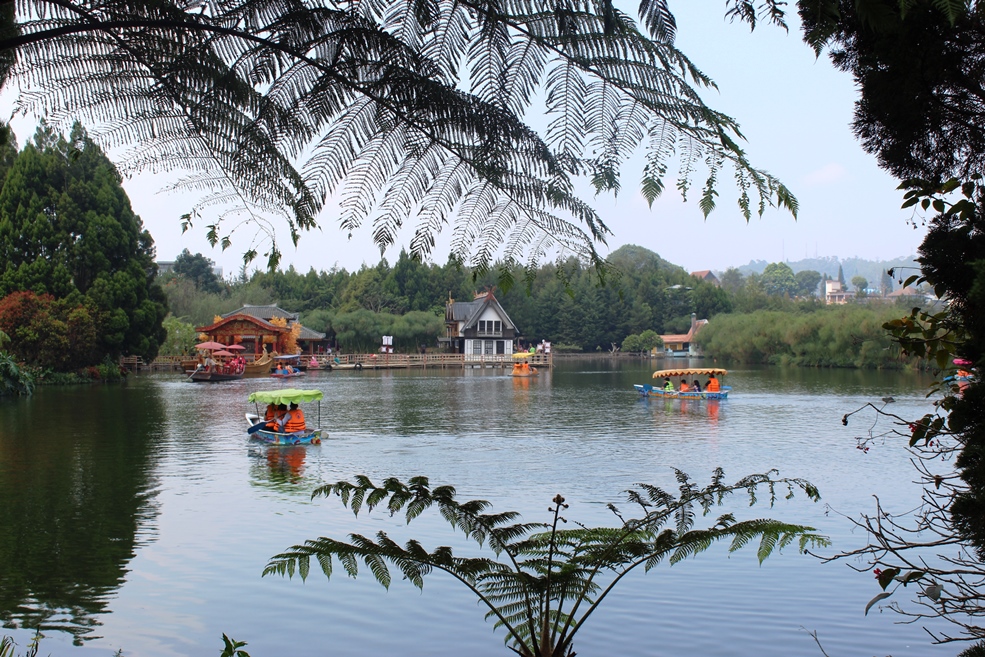








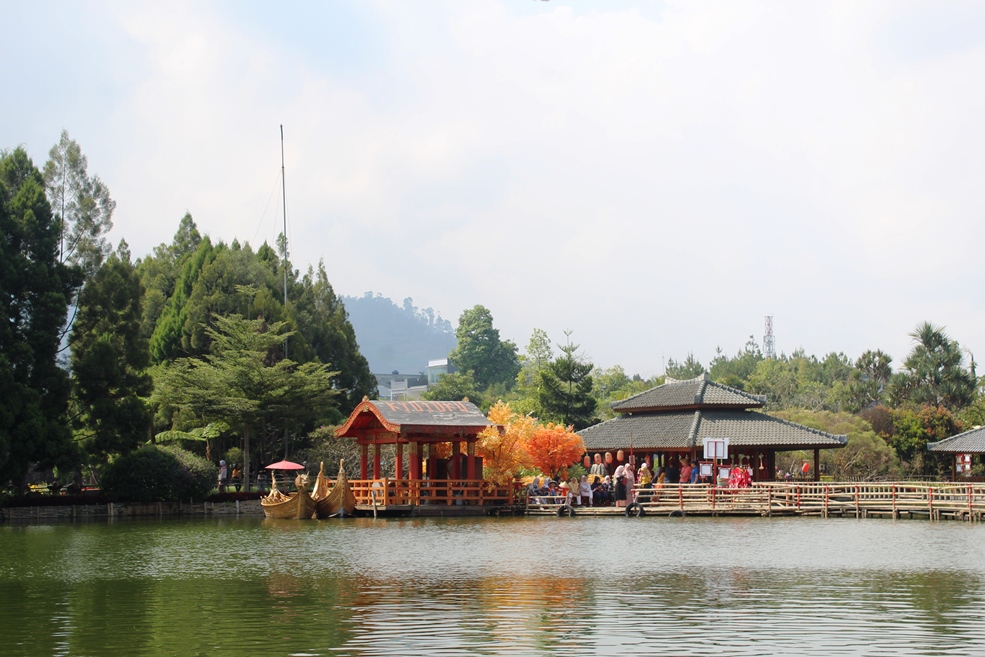



In the afternoon, we return to Bandung and more precisely to the "Saung Angklung Udjo" to attend a very interesting dance and traditional music show.
Two hours of show between wooden puppets (wayang golek), the circumcision ceremony of the kids (helaran), the angklung concert (difficult instrument made of bamboo canes with a very relaxing sound) up to the interaction with the audience with songs and very engaging dances.
Don't miss the chance to jump in the "Chinese" street of Surdiman Street, not far from our hotel and where you can taste many special and tasty Chinese specialties, one of the few places where you can still eat pork!
Batu Karas, 32 km from the most famous Pangadaran, is a sleepy fishing village with a beautiful black sand beach suitable for surfing and sheltered by a rocky promontory. We employ more than nine hours of private car to reach it.
Having a black sand, the sea is not particularly suggestive, moreover, the waves do not make it particularly suitable for those who are not very good at swimming but we have decided to stop here for a week to recharge a bit, after all we are around from almost two months…












The typical day, in a similar place is: relax alarm clock; breakfast with fresh fruit and banana pancakes; morning on the beach among the clubs of the nearby cities, the women who take a bath fully dressed and some small Australian surfers; lunch in a small walking bar of an old lady with mustard-yellow veil with noodles without "baso" (cow's intestine balls); afternoon among sand castles and travel and evening toys, dead tired, with an excellent dinner in our beautiful guesthouse: Villa Monyet just in front of the Ocean!
Yogyakarta. The cultural heart of Java, pronounced "Jogiakarta", abbreviated Yogya, is the city where traditional Javanese arts are most widely cultivated and, the Javanese spoken here, is considered the most refined.
It is also a renowned cultural center thanks to the academies and universities and proudly defends its autonomy and its customs, think that it is still governed by a sultan with a fortified palace, or Kraton, which has remained the fulcrum of traditional life.
The city has its most commercial heart in the lively JL Malioboro, which connects the train station to the Kraton. There are only souvenir shops, which sell mainly shirts and traditional clothes and street food shops but less inviting than Thai.
Time to return to rest a little! Here we stay at the Ndalem Maharani Guesthouse, pretty and central.



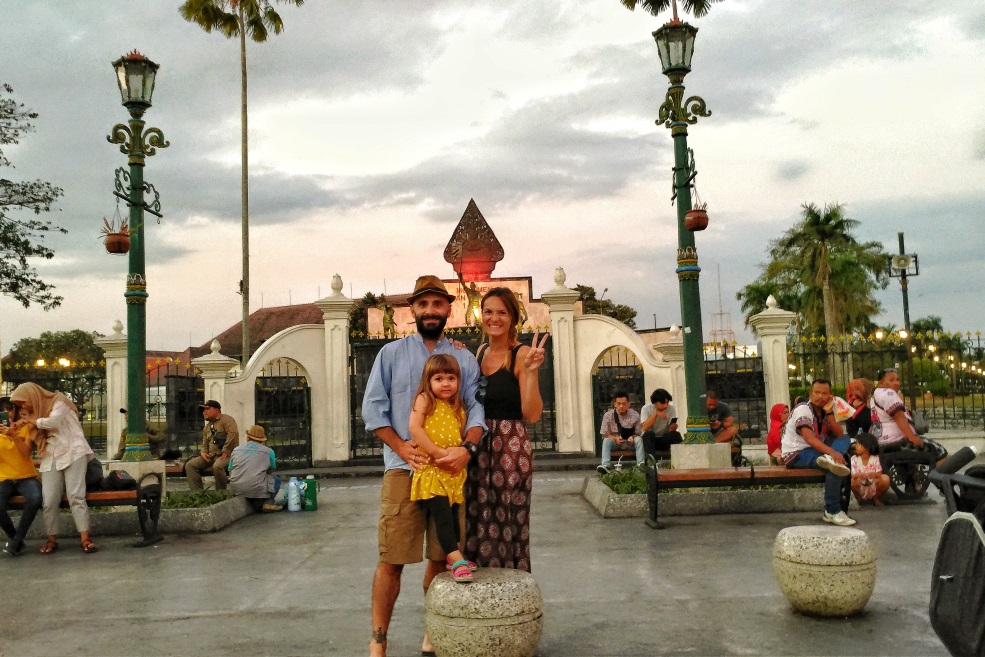







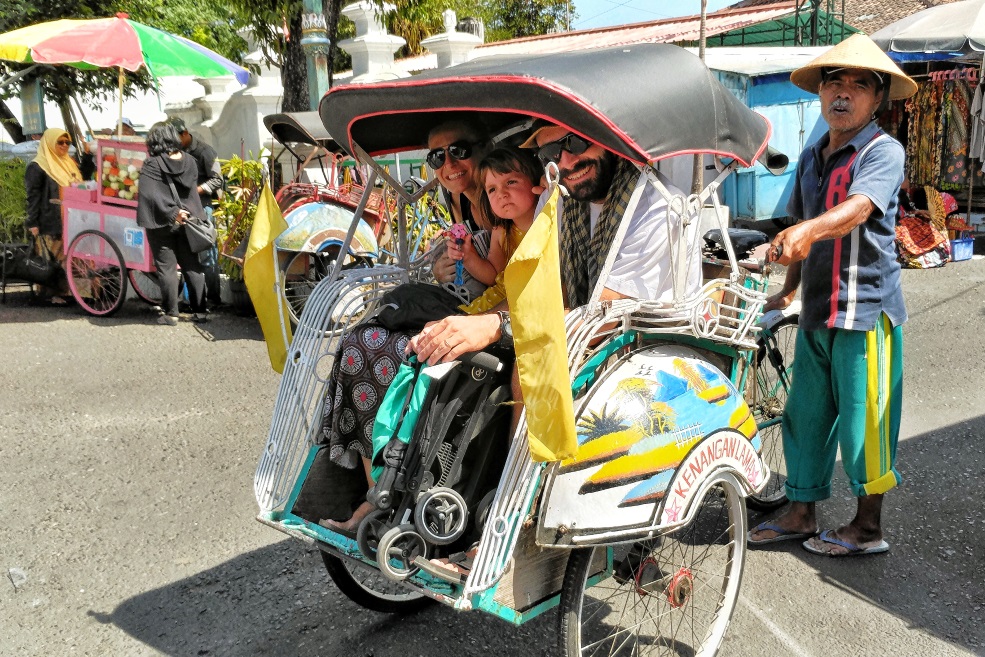





Today we focus on the Taman Sari (water castle) or "fragrant garden", once it was a splendid park with palaces, basins and canals for the sultan and his court. The Portuguese architect who designed it in 1750, was later killed by the sultan to preserve the secret about the most intimate rooms.
The castle has partially collapsed, and partly surrounded by dusty alleys, modest dwellings and batik or souvenirs shops, but still retains its ancient mysterious charm.


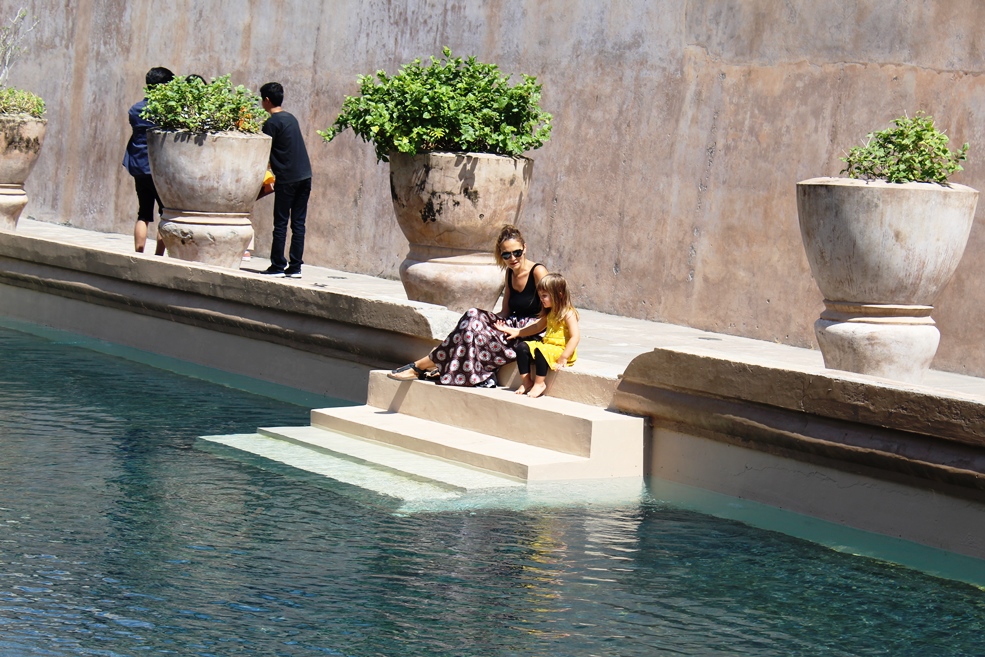




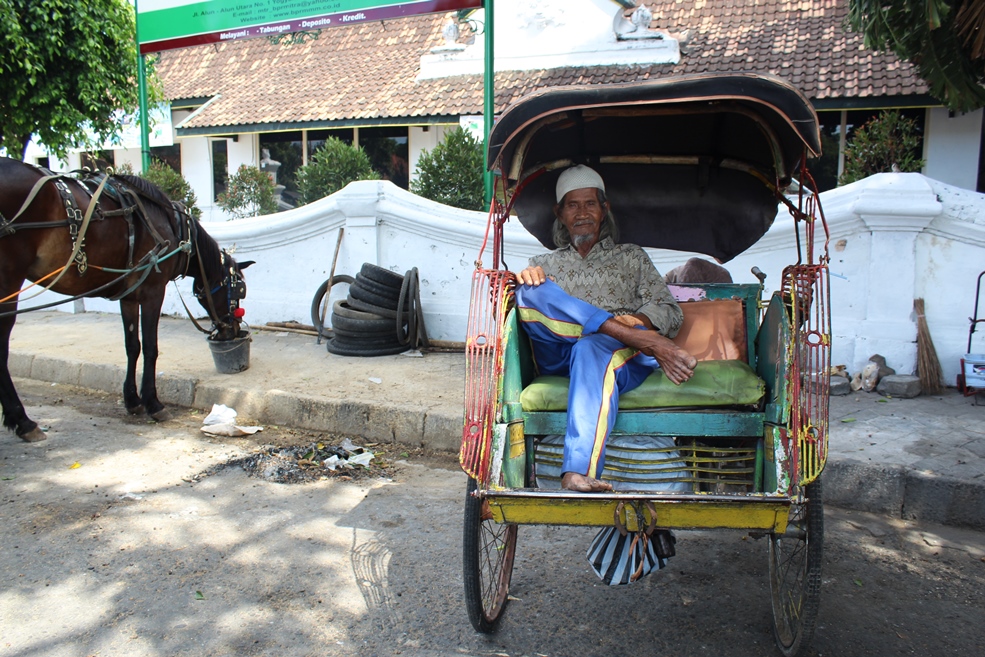
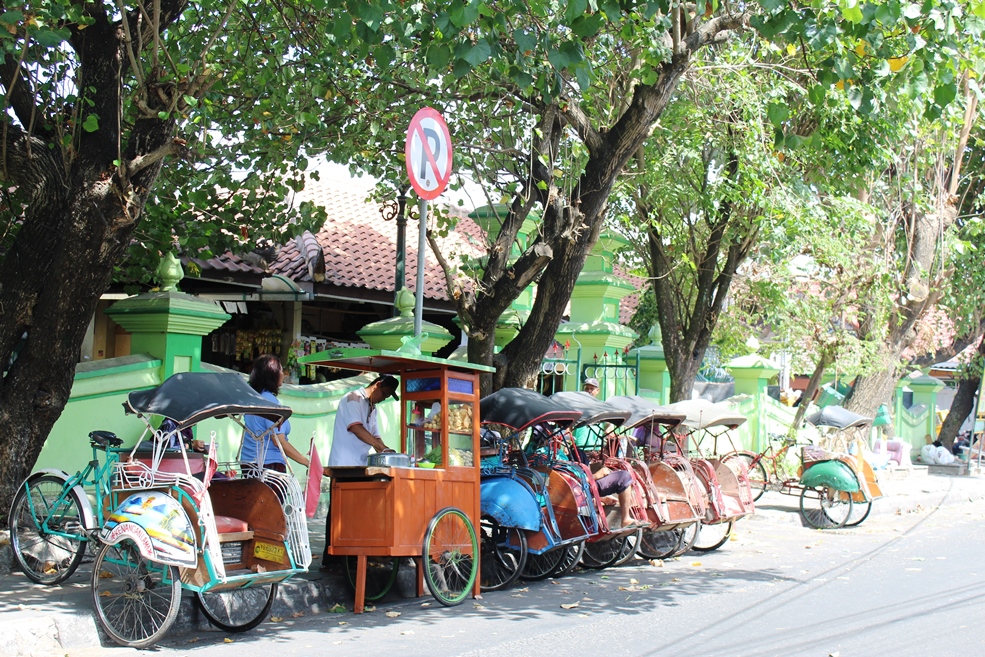
Not far from Yogya, about 40 minutes by public bus (cost 35,000 rupees, about 20 euro cents against the 20 euro requested by taxi drivers) stands the majestic Prambanan Temple.
These are the most fascinating remains of the Javanese Hindu civilization. Today only 8 temples are visible on 244; the largest is the one dedicated to Shiva, with a spire of 47 meters and decorated with a profusion of sculptures.
The vivid scenes carved on the inner wall along the perimeter of the temple are taken from the "Ramayama" and tell of the abduction of Sita, wife of Prince Rama and how, Hanuman, the god of monkeys, managed to free her.
The visit is interesting also because the site is very picturesque and you can buy a combo ticket with Borobudur but it is valid only if, the two sites, are visited on two consecutive days.






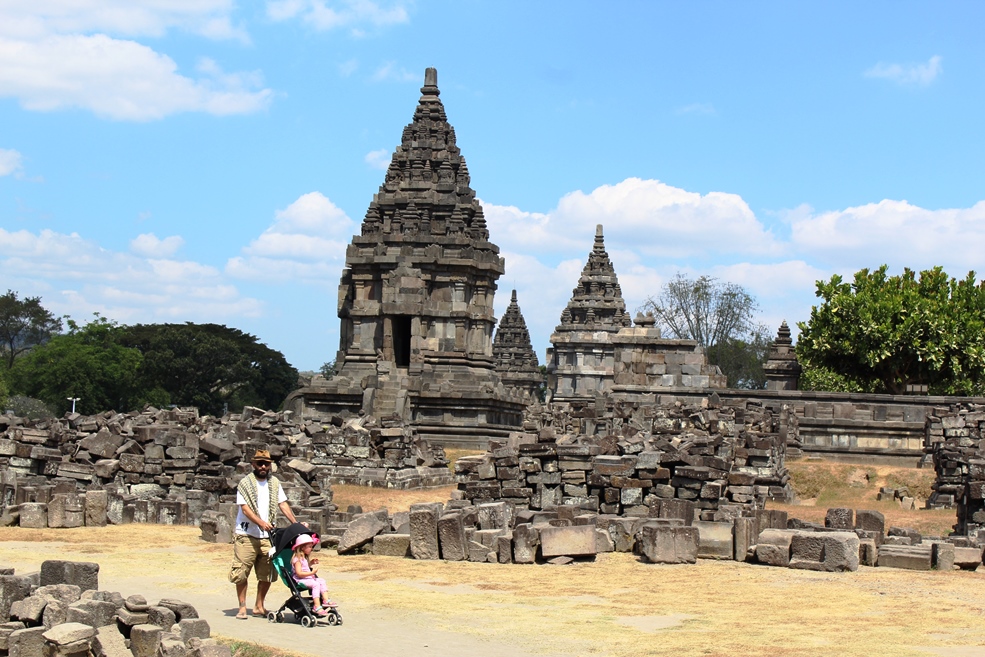


Easily accessible from Yogyakarta is the majestic site of Borobudur. We decide to spend three days here to enjoy, without haste, the magical flavor of this mysterious place.
We stay in a small guesthouse managed and created by Bobby, a friendly Indonesian and his sweet Korean wife Seo. Janur Bungalow is a small jewel of art, a true oasis between the rice and sugar cane fields where each of the 5 rooms has its own personality and character. We simply adored him from the first moment we crossed the colorful entrance ... not to mention breakfast in the pool ... you got it right! Right inside!



















A small hill rises above the palm trees, rice fields and sugar cane fields. It is covered by one of the largest Buddhist monuments in the world: Borobudur. The beauty of Angkor Wat or Bagan; not much is known about the history of this site but, certainly, the saliendra kings had to mobilize an impressive army of workers to cut, transport and sculpt the 60,000 square meters of stone.
The name Borobudur derives from the Sanskrit "Vihara Buddha Uhr", meaning "Buddhist monastery on the hill".
the temple has the form of an imposing stupa; it is not surprising only for its size but also for the details of its sculptures.
Ships, elephants, girls playing and dancing, warriors and kings are represented. More than 400 buddhas look serene from the open rooms above the galleries.
It is believed that touching the fingers or the foot of one of these Buddhas brings good luck.







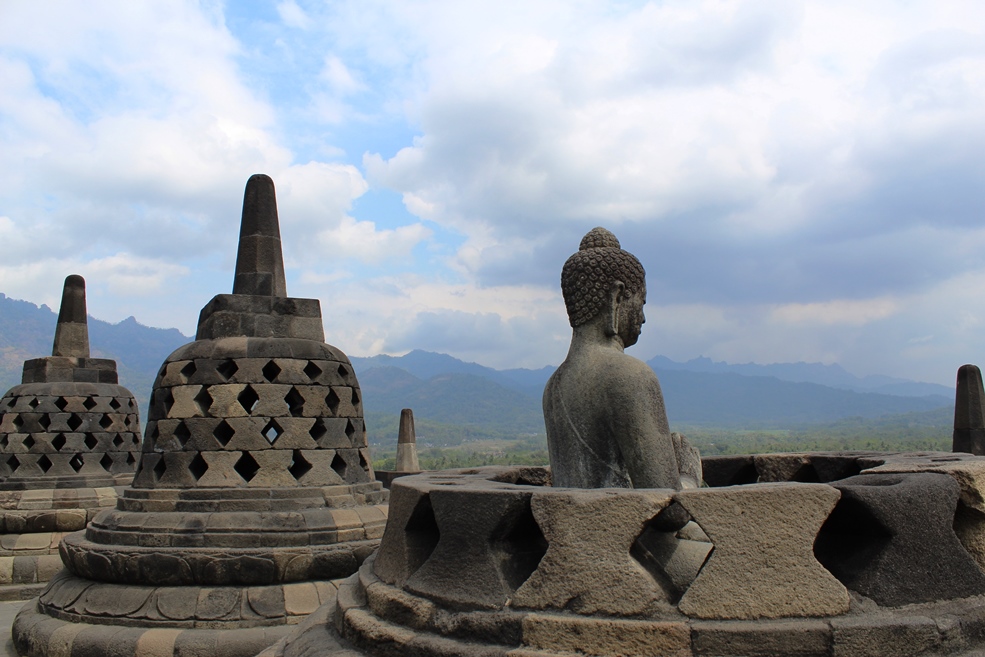




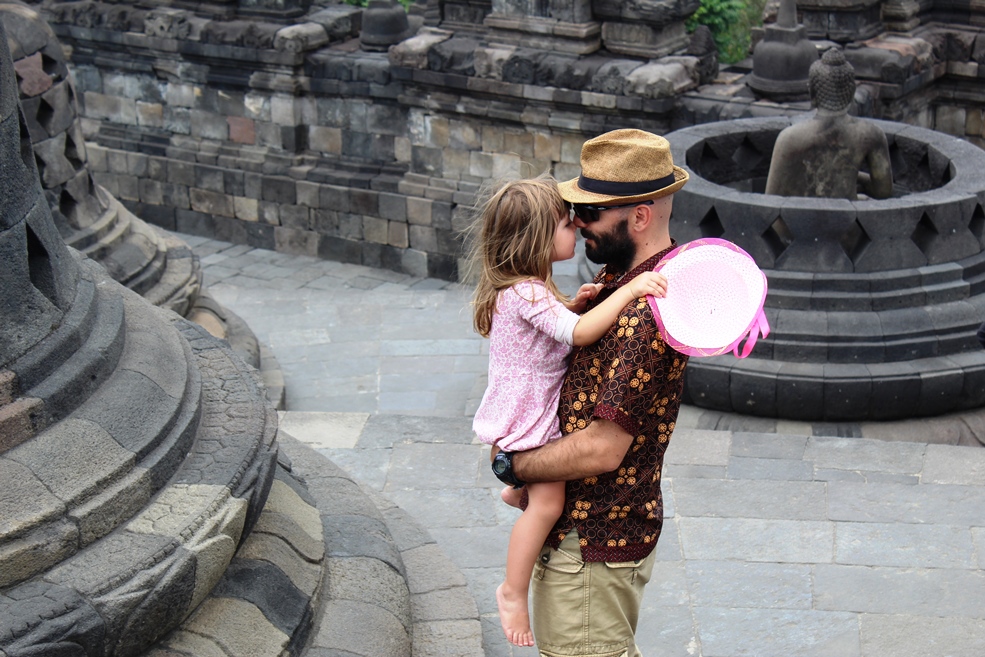

The ancient royal city of Surakarta (better known as Solo), which, with Yogya, is considered the true center of Javanese culture.
Famous for its dance and music academies, universities and for the protection of ancient traditional arts and batiks.
It is a very lively and chaotic city, unfortunately even here the traffic of cars and scooters is unnerving as well as making the air not pleasant.
Very characteristic is the Kraton, the Palace of the Sultan that, after a period of decline and abandonment, is now slowly flourishing again thanks to the opening to tourists.
The thing that struck us most were the murals that adorn, revive and embellish the historic center; there are everywhere and all well done that trace the ancient and modern history of the city.
In the evening we get sucked into an elegant Muslim wedding that was celebrated on the terrace of our hotel; it is always so interesting to observe and admire the ancient rites of marriages around the world, customs handed down over time and full of meaning that fill your heart!




Surabaya is second only to Jakarta in terms of size and economic importance. For centuries it has been one of the most vital ports in Java and, despite being a growing city, it has its narrow streets in the old part, still full of emporiums and becak (handcarts) that contrast with the modern buildings of the historic center.
We decide to reach it by train, as we recommend: a little because in the last few years the Indonesian railway network has developed incredibly but above all to enjoy, for the last time, this postcard-like landscape from a privileged point of view. Green rice fields, endless sugar cane fields, palm groves and occasionally some small villages before entering the chaotic outskirts of Surabaya! The magic is over!
We stay at the Krowi Inn, a small, fairly central guesthouse, good choice for visiting the city.
For many travelers it is only a transit city to reach Bali, to make excursions on the magnificent Bromo volcano or to fly elsewhere (our case), for Indonesians, however, this city has a special significance because it was here that the war started for the independence and there are in fact numerous monuments dedicated to the heroes of this important event in Indonesian history; not for nothing is also known as: "Kota Pahlawan" (city of heroes).
Error: No feed found.
Please go to the Instagram Feed settings page to create a feed.
10 Responses
Interesting write up enjoyable to read and beautiful photos
Thank you so much, I really appreciate your support!
Thank you for visit our country. I will recoment another places.
Nusa penida, labuan bajo,borneo,wamena,and belitung island.
Thank you very much, it’s not the first time we visit some islands of your amazing Indonesia and it will not be the last as well. You live in a such interesting Country!
Thanks for following us!
Bravissimi! Fortunati i vostri figli ad avere genitori come voi, cittadini del mondo.
Fantastici! Dedicate questo post a tutti quelli che pensano che con i bambini piccoli si possa andare solo nel villaggio turistico in Italia. Partite appena potete e teneteci aggiornati
Ciao Susanna, in effetti la maggior parte delle persone hanno cercato di scoraggiarci ma noi siamo andati per la nostra strada… e finora, credo, abbiamo fatto bene
sicuramente la bimba si farà un bagaglio di esperienze che rimarranno dentro di lei per tutta la vita, mi ricordate un po i miei viaggi che facevo con mia figlia 40 anni fa attraverso l’oriente. Oggi a distanza di tanti anni spesso racconta ai suoi figli i viaggi che faceva quando era piccola.
40 anni fa l’Oriente? Non oso immaginare cosa possa essere…
È il mio desiderio più grande, sto con questo desiderio affinché possa realizzarsi nonostante questa funesta pandemia. Grazie per il vostro esempio
Forza Cecilia, passerà e ritorneremo a viaggiare con una consapevolezza diversa e godremo ancora piu’ intensamente la bellezza dei nostri viaggi